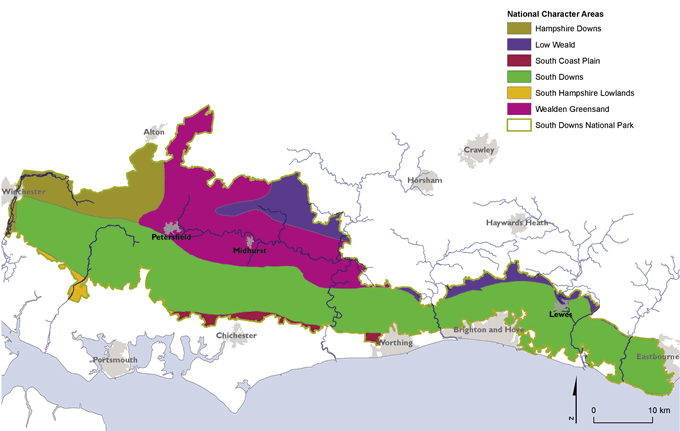 |
For a diagrammatic version of this Fact File |
The landscapes, biodiversity, cultural heritage and economy of the South Downs National Park are being, and will in future be, impacted by climate change. Although the landscapes of the South Downs are dynamic and have adapted to change throughout history, the scale and speed of change we are seeing now may be unprecedented, and some elements may be more adaptive, or more vulnerable, than others.
Working with the statutory agencies, the National Park Authority will continue to monitor trends, and the potential impacts, of climate change.
We are looking for help to monitor climate change trends.
Historic assets such as barrows, hill forts and buried archaeology are sensitive to rainfall, erosion and encroachment by vegetation. If current and projected trends continue these features may be adversely affected.
Since 1990, southern England has experienced an increase in soil moisture deficit, with a corresponding increase in water abstraction for irrigation. In spring 2011 the region experienced much drier than average conditions, causing problems for farmers. If these trends continue we may see a decline in yields or loss of crops due to drought.
The south east has seen a notable increase in risk on the UK wildfire index. The trend towards hotter, drier summers may see an increased fire risk on lowland heath.
Observed sea level rise between 1970 and 2000 has been around 50mm and now averages 3mm per year. If this trend continues the effectiveness of coastal defences may be reduced, increasing the risk of coastal flooding.
Sea level rise may affect the natural functioning of tidal rivers and estuaries.
From 1960–1990 the annual average temperature for the UK increased. Projected increases in mean temperature could be 2.8ºC or greater, along with a decrease in average rainfall of 19%.
UKCP09 projections suggest that by 2050 we may see hotter, drier summers, changing rainfall patterns, and an increase in extreme events such as flooding.
In the winter, the mean temperature increase could be around 2.2ºC, with an increase in average rainfall of 16% across the south east region.
The balance of tree species in our woodlands may be changing: for example, beech is more sensitive to drought and sun-scorch than ash. The spread of tree pathogens northwards is of concern.
The UK has experienced a long-term trend in warmer growing conditions since the 1970s, leading in the SE to a larger area of land under vine production. If this warming trend continues better adapted crops such as fennel and soya bean may become important, and a longer growing season may offer the potential for double cropping.
Hedgerows are vulnerable to drought. This may lead to a lower diversity of hedgerow flora and a reduction in habitat connectivity.
Some chalk grassland species are more sensitive to drought and heat stress than others. Species composition can change, with conditions favouring some grasses. Sites under 5ha are more vulnerable as they have less resilience. Small isolated fragments of habitat may be lost.
The economic impact of soil degradation in England is currently estimated at between £250 and £350 million per annum. Increased cycles of drought and flooding are projected. This may impact on soil condition with increased erosion and nutrient loss/run-off on some steeper slopes.
The cost of damage to UK properties through flooding has reached around £1.3 billion per annum. More extreme rainfall events, such as in 2007, 2009 and 2012, have caused significant disruption and damage. If this trend continues, there may be increased risk of flooding of properties and agricultural land in river valleys and low lying areas.
Average UK insured losses through windstorms are now £620 million per annum. Extreme storm events such as those in 1987, 1990, 2001 and 2007 may become more frequent. This may result in loss of trees, disruption to public services and damage to property.
More information on projected changes can be found in the United Kingdom Climate Impact Programme (UKCIP) report (2009) and the United Kingdom Climate Change Risk Assessment Report (2012). Natural England have also produced a summary report Responding to the Impacts of Climate Change on the Natural Environment: The South Downs National Park (2010) which looks at the vulnerability of features at a landscape scale.
